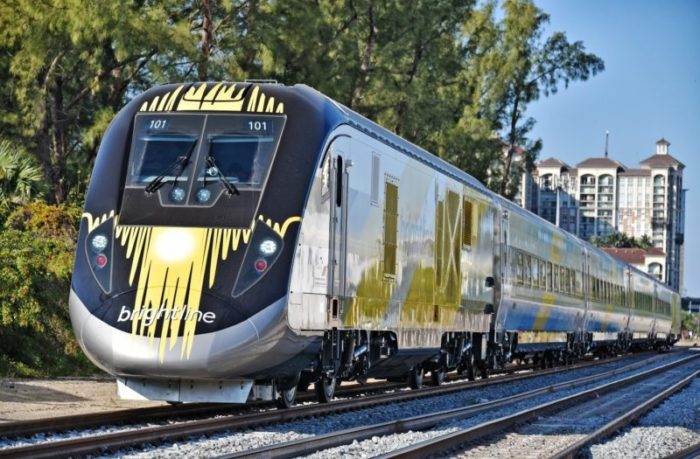Two Kinds of Passenger Trains.
We’re constantly subjected to news stories, opinion columns and letters-to-editors from people who believe that passenger trains should either operate at a profit or cease to exist. “Subsidy” is anathema to those folks. Setting aside the inconsistency of that position given that all other forms of public transportation are subsidized, operating rail passenger service without a modicum of government support in some form is a very dicey proposition.
In order to have a fighting chance at profitability, passenger trains need passengers. Lots of them. Enough ridership to generate enough revenue to make the enterprise work. As a practical matter, that means any new for-profit passenger service has to operate along high-density corridors or, at the very least, provide a connection between two major markets.
It’s encouraging to note that there are a surprising number of corridors that might be able to support profitable passenger trains: Los Angeles-San Francisco; Cleveland-Columbus-Cincinnati; Dallas-Houston; Chicago-St. Louis; Chicago-Minneapolis; Denver-Salt Lake City; Tampa-Orlando; Miami-Orlando; and a few more.

Despite all that potential, there are currently plans for only two for-profit trains: the Brightline trains, which will operate between Miami and Orlando and a true high-speed train linking Houston and Dallas proposed by Texas Central Railway. It’s the consensus among transportation people that both will succeed.
Brightline has run into passionate opposition from some of the residents along the route which already exists for the parent company’s freight operation. The residents claim that Brightline passenger trains running at speeds of 100 miles per hour on existing track will mean the end of there world as they know it.
Meanwhile, it’s a different ballgame in Texas because they’re starting from scratch. Among other things, that means Texas Central will have to acquire the right-of-way and lay their own track for their 200 mph trains. In many cases, the narrow strip of land needed will have to be acquired by eminent domain … that is, private land being taken for a public purpose with fair compensation being paid to the owner. I gather that more than a few of those Texas property owners feel that this is over-reaching by gummint and oppose the project as a matter of principle. (I’m sorry, but if you’ve ever traveled across that part of Texas, it’s hard to imagine that giving up a narrow strip of land would even be noticed, let alone missed.)
Of course I’m in favor of these two projects. Assuming hurdles are cleared and both become reality, perhaps other private investors will be encouraged enough to try in one of the other corridors. But in the meantime, let us not forget that there are two kinds of passenger trains: those that fill a need and can actually make money and those that just fill a need.
We need both.





I’ve often thought about why so many people are good with the HUGE subsidies for aviation, but against the trivial Amtrak subsidies. I’ve concluded it is because the aviation subsidies are mostly hidden behind the scenes – air traffic controllers, FAA, airport construction, etc. – while the Amtrak subsidy goes to the operating company. I bet you have had the experience while traveling on Amtrak where someone starts complaining about the condition of the equipment, the lack of frequency, the poor food and/or service,etc and then says “we should shut off Amtrak’s subsidy until they fix those problems…” I never know whether to get into it with them or just let it go so I don’t ruin a meal arguing with an idiot.
I’ve found that most of those people really never thought about the subsidies for aviation … and, of course, some are just unable to equate that kind of government support with a direct subsidy. That’s when I say we’ll just have to agree to disagree … and order another glass of wine.
But nobody really complains about the direct operating subsidies for city transit or regional commuter rail. When we can get the thinking along the same lines for city transit and regional commuter rail and equate it to Amtrak, nobody will bother to bat an eye. Funny thing is, I’ve never heard a conservative threaten to cancel an entire city bus service. Maybe the mobs would do more than just vote them out of office. Again, this is why I believe by converting Amtrak into a public transit agency, it could negate any argument about funding as any public transit agency is always funded. As you’ve stated before Jim, Amtrak has a fare box recovery ratio of 93%. The federal minimum for public transit agencies is 20%. So, Amtrak being a public transit agency with a recovery of 93% far exceeds federal standards. I’d like to see then how those could argue that our national train network is a waste when large cities only recover 20% of the money required to operate them.
Apparently, there is concern in Washington that the Trump budget is going to propose slashing federal subsidies for commuter rail and transit. That’s along with shoving the cost of Medicaid off onto the states. And isn’t that swell!
> But nobody really complains about the direct operating
> subsidies for city transit or regional commuter rail.
Seriously? Speaking as a transit advocate – we have to fight this battle constantly. Transit is savaged endlessly as a bloated social welfare program.
> I’ve never heard a conservative threaten to cancel an entire
> city bus service.
Honestly… I find this hard to believe. We have faced ballot referendums to exclude transit from – and refuse funding for transit in – adjacent cities. This is an exhausting fight that never ends.
I bow to superior knowledge and greater experience. Here I am, out here in the middle of the Pacific, and far from the action. I am just not aware of any serious attempts too actually shut down metropolitan transit systems. I guess it’s because these are essentially local issues and the national media doesn’t cover them. At any rate, that’s my excuse and I’m sticking to it!
You are luck to live there. In the midwest most media outlets are fiercely suburban in outlook and the coverage of transit is very biased against – “they could be fixing potholes with that money” kind of coverage. One railroad executive commented to me that one of the things he dreads the most is any mention in the local papers. According to the local media transit is for poor colored people – except sometimes the social engineering programs of the city force white people to ride it too – and trains? They are obsolete, dangerous, and loud – novelties kept alive by buckets of subsidies that could be used to fill potholes.
Ignorance abounds. And, as of this morning, the Trump budget has been released and it eliminates all federal funding for Amtrak’s long-distance network. NARP is mounting a call to it’s members to contact their members of Congress ASAP. The irony, of course, is that the long-distance trains serve virtually all of the states that went for Trump. Go figure.
Yes, and as these services emerge, perhaps it’s time to think about interline ticketing (somehow a Brit Rail Pass is good on Arriva or First Great Western or Virgin alike) and connectivity among the various trains (Brightline complementing the Silver trains or the Auto Train, for instance). Serious ferroequinologists can work out the intricacies of Metra rather than Amtrak or South Shore on Metra Electric, but that’s just more hassles for a tourist bound for the Museum of Science and Industry in Chicago or Disney World.
Hear, hear! Amtrak already has Amtrak Thruway for buses, so why not for other transportation, too? Via Rail Canada works together with Maritime Bus to supplement their trains (who only run to Halifax 3 times a week), and to offer passengers through-connections to destinations not served by train. And even within cities, there are different solutions for the ‘last mile’, like the Plusbus ticket sold by British railway operators, or the City-Ticket from Deutsche Bahn.